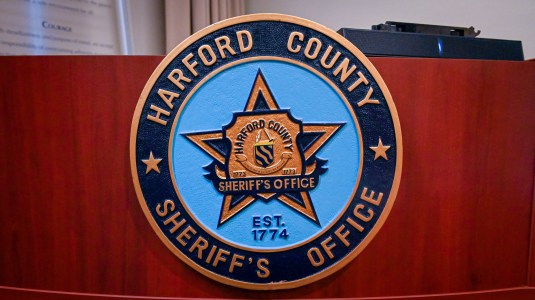
Maryland transportation officials hope to replace acres of underused parking lots near Reisterstown Plaza subway station in Northwest Baltimore with residential units, retail space and public park space.
The Maryland Department of Transportation released a “vision plan” Tuesday for redeveloping the area surrounding Metro SubwayLink station, located near a spaced-apart collection of office parks and large parking lots in Northwest Baltimore. Later Tuesday, the U.S. Department of Transportation said it was awarding the state nearly $4.7 million in grant funds for preliminary design and environmental work for the project; an estimate of the full cost of the development was not available.
Officials aim to turn the nearly 26-acre plot of land off Wabash Avenue into a walkable, mixed-use “destination” and transit hub by building housing and amenities as well as through “major enhancements to pedestrian infrastructure” that would encourage the use of mass transit, the state’s transportation department said in a news release.
Maryland Gov. Wes Moore said in a statement that investing in transit-oriented projects like the one planned for Reisterstown Station “will help us build stronger pathways to prosperity, especially for communities that have been historically left behind.”
“To unleash Baltimore’s promise, we need to make it easier for Marylanders to travel from where they live to where opportunity lies,” the Democrat said in the statement.
Transportation officials said Wabash Development Partners, the group led by developer Dean Harrison selected to build out the state’s transit-oriented vision, is expected to break ground on the project in fall 2025.
The state transportation department has been working with the city residents, local businesses and leadership from the nearby New Psalmist Baptist Church to “really make this into something that can be a gamechanger for the community,” said Tony Bridges, the agency’s assistant secretary for transportation equity and engagement.
Bridges, who represented the area during his tenure as a state delegate for District 41, said the residential areas near the metro station are “very walkable,” though “one of the challenges is actually the walk through” the metro station area.
The subway station is located near a handful of major employers, including a handful of Maryland Transit Administration facilities, a Social Security Administration office, a city district courthouse, the American Red Cross and businesses at Reisterstown Road Plaza itself. But subway riders have to traipse through roads and grassy patches of business park land to get to some of those locations, as most of the current infrastructure there is built for car commuters.
The proposed redevelopment aims to improve access to the station, in part through pedestrian facilities on Patterson and Wabash avenues. In a letter supporting the state’s application for federal project funding, a contingent of Baltimore-area congressmen — Sens. Chris Van Hollen and Ben Cardin as well as Reps. David Trone and C.A. Dutch Ruppersberger — described Wabash Avenue as an “unfinished six-lane arterial road which lacks pedestrian facilities and serves as a barrier to transit access.”
But on top of simply improving pedestrian access, the development project seeks to reshape that area to capitalize more on the mass transit station at the heart of it. Officials proposed in their vision plan to include more than 800 rental and homeownership units, including workforce and senior housing, on top of restaurants and other neighborhood fixtures. About 53,000 square feet of retail space would be spread across eight buildings, and a little less than 5 acres would be dedicated to green space.
Although the project would be built on top of the current 700-space parking lot outside the station, officials proposed to include a parking garage with electric vehicle charging and spaces dedicated for transit riders.
The transit-oriented development project is “trying to improve what we have currently in terms of a metro station and really transforming that site from an underused park-and-ride lot into really a vibrant community location,” Bridges said.
Reisterstown Plaza will be the state’s first transit-oriented development project under Moore’s administration, which appointed then-Del. Bridges in 2023 to serve under new Transportation Secretary Paul Wiedefeld. Bridges noted that approximately 179 acres of undeveloped property sit along the rail line and said the department hopes the project will be a “catalyst” for more transit-oriented projects.
Bridges said transportation officials are learning from similar projects throughout the state, citing recent redevelopment work at New Carrollton Metro Station — a busy transit hub in suburban Prince George’s County located on the Washington-area Metro system — as a “model for transit-oriented development.” The transportation department said last November that the Maryland Economic Development Corporation had awarded two contracts to HR&A Advisors, a national consulting firm, to identify sites with strong market potential for transit-oriented development in the Baltimore area and along the MARC’s Penn Line.
“This is the first one that were using to make sure that we’ve got a modernized look at what transit-oriented development could look at for the rest of the state,” he said.
The Baltimore-area subway system, a single rail line estimated to carry around 400,000 riders each month between the Johns Hopkins Hospital and Owings Mills, has aged significantly since first opening in 1983. State transportation officials are in the process of replacing the aging fleet of subway cars, Bridges said, as well as its light rail fleet.
He said that as ridership rebounds from the coronavirus pandemic and the state tries to encourage mass transit use, the agency is looking to ensure its riders have access to “equitable and reliable transportation” as well as “a system that people want to use.”



